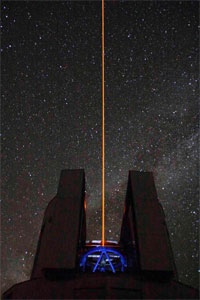How to lose your twinkle
The Subaru telescope will be improving its
eyesight by a factor of ten with the completion of a new adaptive optics and
laser guide star system. For the past five years, Subaru’s adaptive optics
development team had been working on developing an advanced adaptive optics
system to better remove the twinkle from starlight passing through Earth’s
atmosphere.

Testing the laser guide system
The Subaru telescope will be improving its eyesight by a factor of ten with the completion of a new adaptive optics and laser guide star system. For the past five years, Subaru’s adaptive optics development team had been working on developing an advanced adaptive optics system to better remove the twinkle from starlight passing through Earth’s atmosphere.
At the same time, the team was developing a laser guide star system that can create an artificial star anywhere in the sky, opening up a larger portion of the sky to observations with adaptive optics. In October 2006, the team succeeded in testing both new systems on the telescope.
On October 9, 2006, the team tested the new adaptive optics system and obtained an image of the Orion Nebula with ten times better resolution than without adaptive optics. A comparison of the new image with the first light image from when the Subaru telescope began observing in 1999 shows the dramatic increase in contrast and detail seen in the higher resolution image.

Orion Nebula, with & without new adaptive optics
Stars twinkle because light traveling from outer space is blurred by turbulence in Earth’s atmosphere. Adaptive optics technology removes the twinkle from starlight, and allows astronomers to see greater detail in the objects they observe. Subaru’s older adaptive optics system was a 36-element system. This means that it had 36 adjustable parts for smoothing out light to get a sharper image. The new system is a188-element system with five times more adjustable parts to make finer corrections.
On October 12, 2006, the team projected a laser beam into the sky to produce an artificial star in the sodium layer of Earth’s atmosphere, at an altitude of about 90 km. For an adaptive optics system to function, it needs a bright star, called a guide star, near the target object to measure the twinkle. If we rely only on real stars, only 1% of the celestial sphere is observable with adaptive optics. With the laser guide star system, developed by Subaru’s adaptive optics team and researchers from Japan’s Institute of Physical and Chemical Research (RIKEN), the entire sky observable from Mauna Kea will be accessible to Subaru’s adaptive optics system.
Qualitative advances continue in astronomy as in every other scientific endeavor as greater computing horsepower is brought to bear on critical questions. It doesn’t substitute for creative thought, conjecture and analysis — but, it surely helps.
Posted: Sat - November 25, 2006 at 08:07 AM